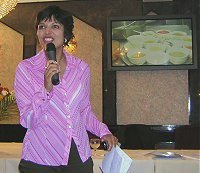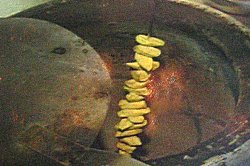| 24th November 2004 |
I go to Southall regularly to re-stock my spice cupboard and buy the most delicious, buttery parathas you've ever tasted but that's usually during the day. I haven't visited Southall in the evening for years and had forgotten just how terrible the traffic can be.
I found myself stuck in virtual gridlock moving slower than the pedestrians along Southall's bustling streets. To make matters worse I was tormented by the enticing smells wafting into my car from the tandoors of the many eateries I was passing and praying that there would be some canapés left when I arrived at the famous Brilliant restaurant. I was travelling to the Brilliant to report on a live debate it was hosting entitled Healthy Profits (with canapés beforehand according to the invitation).
For those of you who have never heard of Southall it is located to the west of London close to Heathrow Airport. Southall is home to one of the most long established and diverse South Asian communities in Britain. The existing communities were joined in the 1970's by Asians escaping from Kenya after being expelled from that country by the government. That's how the Brilliant came into being. Two "Kenyan Asians", Kewel and Davinder Anand, founded the restaurant in 1975 on their arrival in Britain.
 |
|
You can't miss the Brilliant. It has a huge glass frontage and a massive illuminated sign declaring its name. When I used to live in west London years ago everyone knew the Brilliant. It was THE place to go to get authentic Punjabi food at very reasonable prices. Since then the Brilliant has grown in size and stature and has just won the 2004 Good Curry Guide award for Best Punjabi Restaurant in Britain. |
I needn't have worried about the canapés. As soon as I arrived in the banqueting suite on the first floor of the Brilliant I was presented with plate after plate of spicy morsels to choose from. There were aloo tikki (delicate little potato patties), chicken tikka, fish tikka, seekh kebabs (made from spicy minced lamb) and something that looked like roast potatoes but wasn't. More about that later. With my stomach feeling comfy again we all settled down for the debate.
The event was organised by ABi Associates, one of the UK's leading ethnic minority business development companies and was aimed at Asian restaurateurs and chefs of curry houses. Of course, nothing happens for free so an event like this needs sponsors. The generous organisations stumping up the cash on this occasion were the Learning and Skills Council, the London Development Agency and the Phoenix Fund.
OK, credits over; let the debate begin.
The debating panel were Azmina Govindji, a leading dietician and nutritionist and author of The Gi Plan, Qaim Zaidi, the British Heart Foundation's ethnic strategy co-ordinator, Davinder (Gulu) Anand of the Brilliant, Shaheen Zar of the Food Standards Agency and Paul Newman, environmental health consultant. The debate was held together and expertly guided by Dr Toby Murcott, author and correspondent for BBC World Service.
The panel began by telling us of their expertise and explaining why they thought that more Indian restaurants should adopt at least some healthy eating options on their menus.
|
|

the panellists left to right - Shaheen Zar, Azmina Govindji, Toby Murcott, Qaim Zaidi, Gulu Anand, Paul Newman
|
Much of the debate naturally focussed on business-centred topics such as how offering healthier meals would affect a restaurant's bottom line. What concerns you and me though, as the patrons of Indian restaurants, is do we really want the choice of a healthy option when we go out for a meal and, if so, will it taste as good as its less healthy cousin? Fortunately, a fair amount of debating time was devoted to those very questions not least because a restaurant's profits will suffer if its patrons don't like changes that have been made to their menu.
We'll let the panel tackle the second question first. Can a healthy dish taste just as good as its artery clogging counterpart?

Gulu Anand |
|
Gulu Anand's response was bullish "With the ingredients that we use, like the spices, you can still have the same taste, the same flavours, without adding excessive fats to your curry".
"The days are gone" he explained "when you would see floating oils or ghee [clarified butter] in your curry. You're just straight away put off by that. So I have invented the same sort of dishes but using different types of oil - like olive oil or sunflower oil. We have stopped using ghee and butter which are very, very high in saturated fats. The other methods we have used here are grilling, baking and steaming". |
One of the restaurateurs in the audience asked what would happen to one of his best selling dishes, butter chicken, if he wasn't using butter. A good question.
Azmina Govindji's reply was that the restaurant could still make its traditional butter chicken but also market a healthier version. "Change the cream to yoghurt" she suggested "use less butter. It's still called butter chicken but you will create a wider market rather than lose out on people who are demanding the healthier option".
Gulu Anand's solution at the Brilliant was much more extreme. He struck off butter chicken from the menu altogether. He then replaced it with "masala chicken" which uses olive oil to cook the main onion and tomato paste and omits cream and butter altogether.
This sounds revolutionary stuff for a restaurateur so why is Gulu Anand so passionate about it? "I've been running this restaurant with my brother for the past 30 years and 4 years back I suffered a heart attack. This was because of the type of cooking". He was spending so long in the restaurant that he was eating most his meals there. When he suffered his heart attack his cholesterol level was massively high due to all the saturated fats from the butter in which his food was cooked. So, when he was well again, not only did he cut out butter and ghee from his own diet but, with help and advice from his daughter Dipna (a rising star of the future I am sure), revised the restaurant menu so they didn't inflict all those saturated fats on their customers either.
"We've thrown away the ghee pot" he announced to the audience.
And so to the other important question. Would you want the choice of a healthy option when you visit your local Indian restaurant?
| Azmina Govindji responded by suggesting that restaurateurs could ill afford NOT to include healthy options on their menu or they will be neglecting a whole section of the market. Her argument was that health conscious people are avoiding eating in Indian restaurants because it spoiled their healthy eating regime. What she had found in her research was that restaurants which had added healthy options were attracting more customers. "People can eat there more often" she explained "and on most occasions they will choose the healthier options but, on some occasions, they will still go for the unhealthy ones. And that's OK! It's not about denying people their favourite food it's about giving them the chance to have the choice."
|
|

Azmina Govindji
|
At the Brilliant they offer their customers two menus. One is their standard menu and the other is the menu offering healthy options such as the masala chicken and something called matoke. Gulu Anand told the audience that matoke is plantain banana which is spiced, threaded onto skewers and then cooked in the tandoor without any fat. "You had some earlier" he informed us. Ah, so that's what my 'roast potatoes' were and very nice too.
So would you go out to a restaurant more often because they offered healthy options on the menu? I suppose my own answer would be "yes". Although I am not averse to the odd bit of ghee now and again my wife absolutely hates being served curries which are swimming in oil. I don't mind eating unhealthy food now and again as a special treat but that's because I don't cook with ghee in my own curries which I eat regularly. I am especially glad that I too have kicked out the butter after Qaim Zaidi from the British Heart Foundation reminded us about the serious health consequences of an excessive intake of saturated fats.

matoke being lowered into the tandoor |
|
When the debate was over those innovative people from ABi arranged a special entertainment. They had set up a cookery demonstration via a video link to the Brilliant's kitchen downstairs. We were able to see the spiced matoke being lowered into the tandoor and were given a demonstration of a healthy version of chana masala being cooked. I am pleased to confirm that not even a little puddle of oil could be seen on the surface of the finished dish.
And then the evening closed with more food...
|
There was no floating oil either in the wonderfully smelling trays of Punjabi specialities which had been laid out for us. There was tender karahi lamb, a robust methi chicken made with fresh fenugreek leaves, aloo gobi made with perfectly cooked cauliflower and baby new potatoes, a fragrant pilau rice (no artificial food colouring of course) and the most delicious dhal you could imagine.
I left the Brilliant knowing a great deal more than when I arrived. The lively and well informed debate had certainly left me with plenty to think about.
Next time I travel to Southall on one of my buying expeditions I think I'll give my heart a treat by buying some plain chapatis instead of those lovely parathas made with ghee. Well, maybe I'll just buy one pack.
associated links:
ABi Associates
Brilliant
British Heart Foundation
Food Standards Agency
London West Learning and Skills Council
|
|
 UK Curry Scene
UK Curry Scene UK Curry Scene
UK Curry Scene